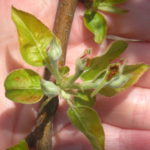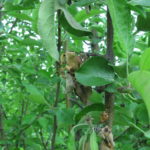In the Midwest, extreme weather events are, unfortunately, regular occurrences, even in extremely unusual times. At this point, though, it just feels like a pile-on. Most fruit crops planted in Indiana are tolerant of the cold when they are fully dormant. In the spring, as trees break bud and begin to flower, they lose cold hardiness. This is especially true of flower buds: Winter cold snaps below -15 F kill dormant stone fruit buds, and any that make out of winter are at risk if temperatures drop to less than 23F during flower development in spring (Fig.1). These cold snaps cause severe damage and often result in crop loss. Early blooming fruit crops (apricot, sweet cherry, peach) are more likely to be damaged due to the higher risk of frost occurring later in the spring than apples, but all can be lost to late spring freezes. Despite crop loss, trees still need to be managed to prevent disease buildup from damaging future crops. This brief focuses on low cost methods to manage tree fruit disease to protect future crops from infection.
Apples and Pears:
Despite the potential loss of fruit crops, disease management, particularly for fire blight, is of the utmost importance right now. Improper management of trees from this point on can profoundly affect future harvests. Freeze injury, much like hail injury, results in damage to young and succulent shoots and leaves, providing a means for the fire blight bacterium to cause shoot blight. Running both Cougar Blight and MaryBlite right now shows zero risk of infection, as temperatures remain below 60 degrees F. Despite the negligible risk of infection, you may wish to protect some of the most susceptible varieties, like Fuji, Gala, and Ida Red (For a list of susceptibility see the new Extension Brief Disease Susceptibility of Common Apple Cultivars, at https://www.extension.purdue.edu/extmedia/BP/BP-132-W.pdf ) especially if these are grafted on M.26 and M.9 rootstocks should temperatures rise above 70 degrees F with rain. Streptomycin or a low rate of copper (0.2 -0.6 lb of metallic copper/acre depending on tree row volume) will provide protection against fire blight. Keep in mind that copper can cause injury on some varieties, and application should occur after the temperatures are above 50 degrees F to prevent phytotoxicity. Suggested coppers include Cuprofix, Kocide, or C-O-C-S. Turner Sutton, at North Carolina State University reports using the 0.2 and 0.4 lb rates on Golden Delicious during the summer without any problem. If you think you might have a crop on a copper sensitive variety, use streptomycin if you are concerned about possible injury and may still have a small amount of fruit to harvest. Should you still have a crop, based upon regional weather forecasts, you should plan on applying streptomycin prior to any anticipated warm weather+rain.
According to the prevailing wisdom, dead flowers that don’t fall off are not good hosts for the fire blight bacterium. Many of our apple varieties at Meigs seem to be asynchronous with their bloom time this year and any of these slow to flower side blossoms or “rat tail” blooms that are still alive can become infected. Continue monitoring until bloom is over, and apply streptomycin as needed, not to exceed four applications per season.
If your orchard has a history of fire blight, I would strongly encourage you to consider applying Apogee (Prohexadione-Ca). Apogee is a growth regulator that does not directly kill the fire blight bacterium, but reduces shoot growth, thereby increasing plant resistance by reducing host vigor. Apogee suppresses apple shoot growth when applied near petal fall as a single spray, or as several applications over time. Apple response to Apogee depends upon the cultivar, timing, rate of application, crop load, and even geographical location. Regardless of this variability, Apogee remains the best management tool available for controlling the shoot blight phase of fire blight that growers may be faced with after a freeze, particularly after the vigor that may result after crop loss.
Despite the potential, or real loss of crop, it is imperative to maintain a least a minimum spray program to protect future harvests. Failure to do so will result in defoliated trees that fail to produce next year, or may not survive the next winter. Normally, the greatest risk of scab would be right now, from pink to bloom. However, nothing is normal about this year. For these reasons, I am recommending:
- EDBC fungicide (3 lb/acre) program through bloom. Alternate with copper or sulfur from second cover on to remain under label limits. Remember to stay within the 21.0 lb/acre/season limit for your EBDCs. I like the EBDCs as they also protect against bitter rot, black rot and white rot. Use this schedule if cedar-apple rust is a particular problem.
- Alternatively, Captan can be used earlier in the season for better scab control instead of the EBDCs, but provides no control of rust or powdery mildew.
- NOTE: Do not use Captan 50 Wettable Powder in combination with or closely following or in alternation with wettable sulfur products, or oil. Sulfur sensitive varieties of apples such as Red Delicious, Staymen, and Baldwin, can suffer severe injury and defoliation. Captan 50 WP has a 64 lb limit per acre per year.
One other option that can be used is copper (0.2 – 0.6 lb metallic copper per acre based on tree row volume) + sulfur (6-30 lb/acre depending on brand/formulation) every 10-14 days between now until the first week in June, depending upon weather conditions. Suggested sulfur formulations include Thiolux, Microthiol Disperss, or Microfine Wettable sulfur. This spray program protects against scab and mildew, and slightly against rust. Remember, copper can russet fruit, and should not be used if you want to use your crop for anything except cider. Do not use sulfur if temperatures are going to exceed 90 degrees F, or drying conditions are extremely poor. Do not use sulfur or copper within two weeks of an oil application. Neither of these programs is going to provide complete scab control but should reduce leaf infections. Organic trials in both Michigan and North Carolina regularly apply 6 lbs of sulfur per treatment without any reported phytotoxicity due to temperature.
If powdery mildew is particularly bad, you may wish to consider applying a sterol inhibitor like Rally or Procure, or a strobilurin like Flint or Sovran prior to second cover to knock down powdery mildew and reduce the likelihood of it overwintering in bud tissue, particularly are on higher value cultivars (like Honeycrisp, Jonagold, etc). Reducing inoculum levels to maintain plant health while reducing overwintering inoculum is important for longterm plant health, and to reduce inoculum buildup which contributes to fungicide resistance.
- Figure 1. Freeze damage to apple blossom buds. Photo by Janna Beckerman.
- Figure 2. In 2021, fire blight still caused infection of freeze killed blossoms in highly susceptible varieties like Gala and Fuji. Photo by Janna Beckerman.

